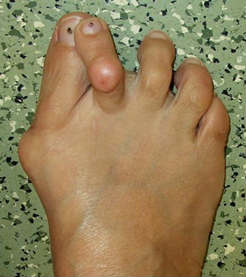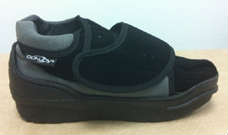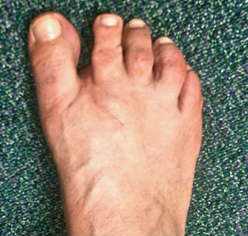 What will the surgery involve?
What will the surgery involve?
i. Anaesthetic – Usually a light general anaesthetic together with a local anaesthetic around the ankle
ii. Scar – There will be a cut over the toe itself, either longitudinal or horizontal.
A further incision will probably be required over the joint at the base of the toe and may need to extend along the bone in the foot that is connected to the toe.
iii. The surgery – The bent joint in the toe itself is straightened this involves releasing the ligaments at the side, possibly then removing part or all of the joint (which then might need to be stabilised with a wire).
The tendon pulling the toe up may need to be released or lengthened.
The bone in the foot connected to the toe may need to be cut and shortened.
Further small modifications may also then be required depending on the position of the toe i.e. if it is crossing over a neighbouring toe- see photo above)
iv. Stitches – Removable sutures are usually used which will be removed at your appointment about two weeks after surgery.
v. Dressings – A special dressing will be placed on the foot that should be left in place until you are reviewed in the out patient clinic.
 A “post operative shoe” will be placed over the dressings.
A “post operative shoe” will be placed over the dressings.
iv. Wires – A wire might be required to hold the toe in the correct position (see above), this is removed in the outpatient department four weeks after surgery, no anaesthetic is required.
What happens after the surgery?
i. Return home – Either the same day or the following morning.
ii. Pain relief – The local anaesthetic placed around the ankle at the time of surgery will wear off several hours after surgery. It is important to take the pain relieving tablets, which will be prescribed for you, regularly before the local anaesthetic wears off. You can gradually reduce the frequency with which you take these after a few days as your pain allows.
 iii. Walking – You will be able to walk (in your ’post op shoe’) as soon as you have recovered sufficiently following the general anaesthetic. You should keep your weight mainly on your heel (your weight distribution will often be determined by other procedures that are required at the time of the surgery- often hammer toe correction occurs at the same time as bunion correction surgery).
iii. Walking – You will be able to walk (in your ’post op shoe’) as soon as you have recovered sufficiently following the general anaesthetic. You should keep your weight mainly on your heel (your weight distribution will often be determined by other procedures that are required at the time of the surgery- often hammer toe correction occurs at the same time as bunion correction surgery).
It is important to keep your foot elevated when you are resting, as much as you can for the first two weeks after surgery (if possible above the level of your heart). If you do not keep it elevated then the foot will swell, throb and be uncomfortable.
iv. Follow up – You will be seen two weeks after the surgery when the sutures will be removed, you will remain in the “post op shoe”.
You will be seen in the outpatient clinic 4-6 weeks after the operation when the wire will be removed.
v. Shoes – You will be able to wear ’more normal’ shoes when the ’post operative shoe’ is removed, usually at 4 weeks following surgery.
You may have some difficulty fitting into your normal shoes at this stage as the foot may be swollen, this can last up to 3 months.
vi. Driving – This is not permitted until you can walk confidently in normal shoes, however if the surgery is on your left foot and you have an automatic car you may be able to drive two weeks after surgery.
In all cases you should check with your insurance company first.
vii. Return to work
Office job – 2 weeks
Mobile job requiring driving – 4 weeks
Manual labour – 6-8 weeks
What are the risks of the operation?
There are a small number of risks of surgery including infection, nerve damage, blood clots, ongoing pain and the need for further surgery (please see General Risks of Foot and Ankle Surgery for further information)
